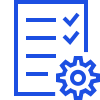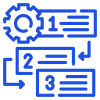Mobile
At Visplu we specialize in designing modern and innovative mobile apps for both iOS and Android platforms. Our team of experts uses the latest technologies and the newest mobile innovations and industry trends to finalize the design. Whether you seek a basic app or a sophisticated, data-centric solution, we are your partner to reach your goals.

Our Process in a nutshell
Mobile app development is a comprehensive process involving several stages from conceptualization to deployment. Here’s a detailed description of the typical mobile app development process:
-

Requirements Gathering
The process begins with gathering requirements from stakeholders to understand the app's purpose, target audience, features, and functionalities.
-

Planning and Analysis
Once the requirements are gathered, the development team conducts a thorough analysis to identify technical feasibility, potential challenges, and project scope. A project plan and timeline are created during this phase.
-

Design
The design phase involves creating wireframes and mockups to visualize the app's user interface (UI) and user experience (UX). Design elements such as layout, navigation, colors, and branding are finalized in this stage.
-

Development
In the development phase, developers start building the app based on the approved design and requirements. They write code, integrate APIs, and implement features according to the project plan. Agile methodologies like Scrum or Kanban are often used to manage the development process efficiently.
-

Testing
Quality assurance (QA) engineers conduct various tests to ensure the app's functionality, usability, performance, and security. Testing includes functional testing, usability testing, compatibility testing, and security testing to identify and fix any bugs or issues.
-

Deployment
Once the app passes all tests and meets the quality standards, it is deployed to the app stores (e.g., Apple App Store, Google Play Store) for distribution to users. App deployment involves creating developer accounts, complying with app store guidelines, and submitting the app for review.
-

Maintenance and Updates:
After the app is launched, the development team continues to monitor its performance, collect user feedback, and address any issues that arise. Regular updates and maintenance are essential to keep the app secure, compatible with new OS versions, and aligned with evolving user needs.
-

Optimization and Iteration
Continuous optimization and iteration involve analyzing user feedback, app analytics, and market trends to identify areas for improvement. New features, enhancements, and optimizations are implemented through iterative development cycles to keep the app competitive and relevant in the market.
Why Visplu?
Choosing Visplu for your mobile application development project brings a host of benefits, each tailored to elevate your business in the digital space:
Strong UX and UI Expertise
Agile Methodology
Guaranteed ROI
High Innovation
Customer-Centric Approach
Costs Factor
Transparent Processes
Continuous Support
High-Quality Services
Mobile Application Development Use Cases
Developed with precision and strategic insight, our mobile applications have been tailored to meet diverse business needs. Solutions ranging from e-commerce platforms to health monitoring systems are meticulously crafted, ensuring each app serves its intended purpose effectively.
E-commerce Applications
Health & Fitness Trackers:
Educational Tools
Financial Management
Social Networking
Productivity Enhancers
Entertainment and Media
Travel and Navigation
Food and Delivery Services
Custom Utility Apps
These are specialized apps that address specific user needs. Our suite of mobile app development offerings is designed to enhance user experience through an assortment of innovative and user-friendly capabilities. Below, we detail the standout aspects of our mobile application development services:
iOS Application Development
Android Application Development
Cross-platform Application Development
Flutter Application Development
React Native Application Development
Wearable Application Development
Frequently Asked Questions (FAQs) about Mobile Developpement
At Visplu, we prioritize the following areas to ensure the success and effectiveness of your mobile app:
- User Insight: We start by identifying the target audience and their preferences, coupled with in-depth market research.
- Platform Strategy: Whether it’s iOS, Android, or both, we choose the best platform approach to suit your needs.
- Design Excellence: Our aim is intuitive design and a seamless user interface for the best user experience.
- UI Consistency: We adhere to platform-specific UI guidelines to ensure our apps feel right at home on any device.
- Performance: We focus on smooth, responsive apps that are optimized for speed and resource efficiency.
- Security: Implementing top-notch encryption and secure data protocols to protect user information.
- Monetization: We’ll help you choose the right revenue model for your app to ensure financial success.
- Scalable Backend: Robust server infrastructure that scales with your app’s growth.
- Data Management: Secure and smart handling of data, always respecting privacy laws.
- Analytics Integration: We utilize mobile analytics to understand user engagement and optimize the app performance.
- Quality Assurance: Comprehensive testing on various devices to guarantee compatibility and quality.
- ASO: Making sure your app stands out in the marketplace with strategic app store optimization.
- Continuous Improvement: We collect user feedback for ongoing app enhancement and update deployment.
- Scalability and Adaptability: Building apps ready to grow and evolve with future technology changes.
- Legal Compliance: Ensuring your app meets all regulatory requirements and respects user privacy.
- Marketing and Launch: Crafting a compelling marketing and launch plan to create excitement and drive downloads.
- Accessibility: We commit to making apps usable for everyone, including people with disabilities.
Let’s break down the main distinctions:
Native Application:
- Custom Tailored: Much like a specialty dish perfected with local flavors, a native app is built specifically for one platform—either iOS or Android—using specialized tools and languages like Swift or Kotlin.
- Optimized Performance: Native apps are the gold standard for performance, fully optimized for their respective platform with access to all hardware features and a seamless user experience that feels ‘at home’ on the device.
Cross-Platform Application:
- Versatile Code: Think of a cross-platform app as a traveller who can navigate multiple countries with ease. It’s developed in a universal codebase, like React Native or Flutter, which allows it to operate across both iOS and Android.
- Consistency Across Platforms: These apps maintain a consistent operation and look across different platforms, making them cost-effective and faster to develop, though sometimes at the expense of the deep optimization native apps can provide.
Let’s distill the essence of each path in the app development landscape:
Native Applications:
Advantages:
- Optimized Performance: Built for specific operating systems, native apps deliver top-tier performance and make full use of device features.
- Enhanced User Experience: These apps offer smooth navigation with transitions and animations that feel native to the device.
Disadvantages:
- Resource Intensive Development: They require separate development efforts for each platform, which means more time and cost.
- Complex Maintenance: Updates and maintenance must be done individually for each platform, doubling the effort.
Cross-Platform Applications:
Advantages:
- Efficient Development: A single codebase for all platforms means faster development and reduced costs.
- Broader Reach: They are accessible to a wider audience as they run on multiple platforms, including iOS, Android, and sometimes web and desktop.
Disadvantages:
- Performance Limitations: These apps may sacrifice some performance and may not feel as ‘native’ as their counterparts.
- Compromised Customization: The “write once, run anywhere” approach may not fully accommodate the unique design elements and functionalities of each platform.
Here’s a concise look at the pros and cons:
Advantages:
- Broader Reach: Develop once and deploy across multiple platforms (iOS, Android, etc.), reaching a wider audience.
- Cost Efficiency: Save on development and maintenance costs since one codebase is used for all platforms.
- Faster Development Time: Speed up the time to market, as you don’t have to write unique code for each platform.
- Simplified Management: Easier app updates and bug fixes as changes are made to a single codebase.
- Unified Design: Ensure consistent UI/UX across all platforms, providing a cohesive brand experience.
Disadvantages:
- Performance Issues: May not perform as well as native apps due to the extra layer of abstraction.
- Limited Functionality: Access to device-specific features might be restricted or more complicated to implement.
- Integration Challenges: It may be more difficult to achieve seamless integration with third-party apps, services, or hardware.
- Inconsistent User Experience: There may be slight differences in the UI/UX on different devices, despite efforts to standardize.
- Dependency on Frameworks: Bound by the limitations and update cycles of the cross-platform framework used.
